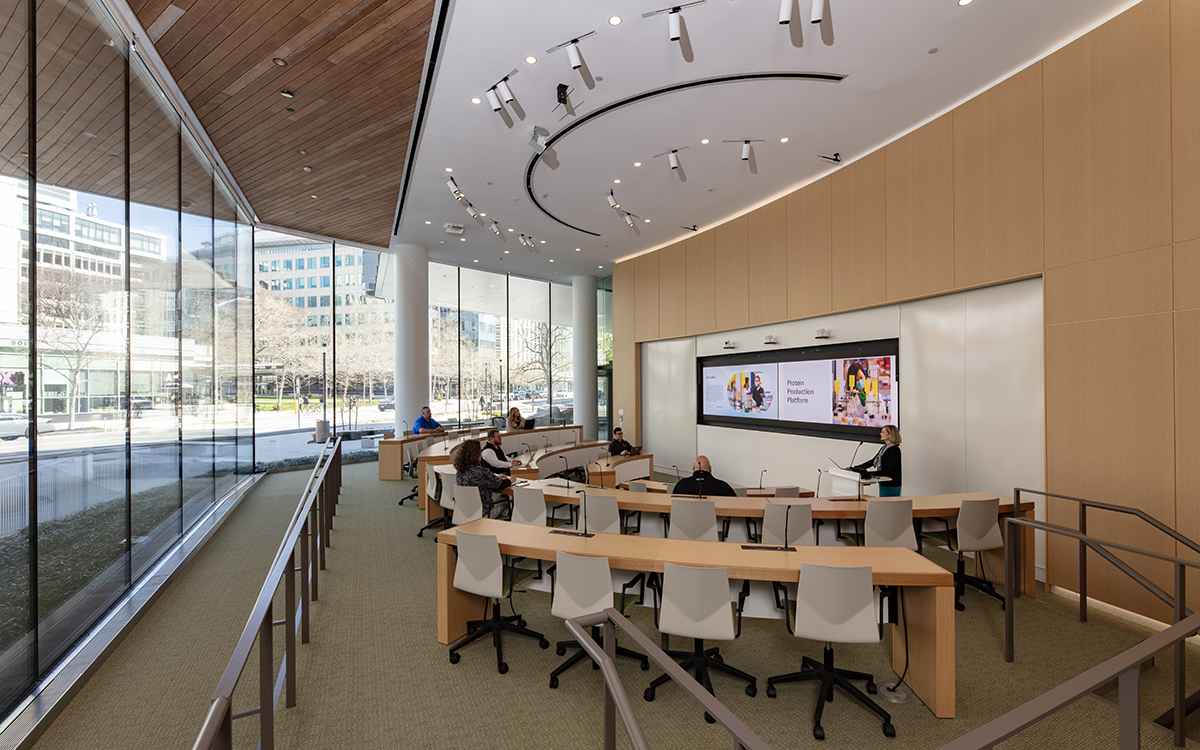Planning a new conference room or collaborative space but at a loss with all the audio visual terminology out there? Not a problem! We’ve created a handy glossary of terms to help you speak like a tech pro!
RED THREAD GLOSSARY OF AUDIOVISUAL TERMS
Ambient Light
All light in a viewing room produced by sources other than the display.
Ambient Noise
Sound that is extraneous to the intentional audio; background noise.
Amplifier
An electronic device for increasing the strength of electrical signals.
Analog
A method of transmitting information by a continuous but varying signal.
ANSI
American National Standards Institute.
Aspect Ratio
The ratio of image width to image height (typically widescreen or standard).
Audio Processor
An electronic device used to manipulate audio signals in some manner.
Audio Signal
An electrical representation of sound.
Bandwidth
A measure of information carrying capacity without distortion.
Bit
Shortened form of binary digit, symbolized by 1s and 0s. The smallest unit of digital information.
Bit depth
The number of bits used to describe data.
Blocking
Pieces of wood that have been inserted between structural building elements to provide a secure mounting point for finish materials or products.
Block Diagram
An illustration of the signal path through a given system.
BNC
A professional type of video connector featuring a two-pin lock.
Boundary Microphone
A microphone that relies on reflected sound from a surrounding surface.
Cardioid
Heart-shaped region where some microphones will be most sensitive to sound predominately from the front of the microphone diaphragm and reject sound coming from the sides and rear.
Category 5 (Cat 5)
The designation for 100-ohm unshielded twisted-pair cables and associated connecting hardware whose characteristics are specified for data transmission up to 100 Mb/s (part of the EIA/TIA 568A standard).
Category 5e (Cat 5e)
Enhanced version of the Cat-5 cable standard that adds specifications for far end crosstalk (part of the EIA/TIA 568A standard).
Category 6 (Cat 6)
Cable standard for gigabit ethernet and other interconnect that is backward compatible with Category 5 cable, Cat-5e and Cat-3. Cat-6 features more stringent specifications for crosstalk and system noise (part of the EIA/TIA 568a standard).
Closed Circuit Television (CCTV)
A system of transmitting video signals from the point of origin to single or multiple points equipped to receive signals.
Coaxial Cable
A cable consisting of a center conductor surrounded by insulating material, concentric outer conductor and optional protective covering, all of circular cross-section. Abbreviated coax.
CODEC
An acronym for coder/decoder. An electronic device that converts analog signals, such as video and audio signals, into digital form and compresses them to conserve bandwidth on a transmission path.
Component Video
Color video in which the brightness (luminance) and color hue and saturation (chrominance) are handled independently. The red, green and blue or, more commonly, the Y, R-Y, B-Y signals are encoded onto three wires. Because these signals are independent, processing such as chroma keying is facilitated.
Composite Video Signal
The electrical signal that represents complete color picture information and all synchronization signals, including blanking and the deflection synchronization signals to which the color synchronization signal is added in the appropriate time relationship.
Condenser Microphones
Also called a capacitor microphone, it transduces sound into electricity using electrostatic principles.
Cone
Most commonly used component in a loudspeaker system and found in all ranges of drivers.
Conferencing Systems
The technology by which people separated by distance come together to share information. Conferencing systems may include projection, monitor displays, computers, satellite connections video and audio playback devices, and much more.
dBSPL
A measure of sound pressure level measured in dynes per centimeter squared. Its reference, 0 dBSPL equals 0.0002 dynes/cm2. dBSPL is used as a measure of acoustical sound pressure levels, and is a 20log function.
Decibel
A comparison of two measurements or values. Abbreviated dB, it is one-tenth of a Bel (a unit of measurement named for Alexander Graham Bell).
Delay
An audio signal processing device or circuit used to retard the speed of transmission on one or more audio signals or frequencies.
Depth-of-Field
The area in front of a camera lens that is in focus from the closest item to the camera to the furthest away.
Digital
A method of transmitting information by discrete, non-continuous impulses.
Digital-to-Analog Converter
An electronic device that converts digital signals into analog form.
Distributed Sound
A sound system in multiple loudspeakers separated by distance and typically operates in a lower sound pressure level than a high pressure system. The loudspeakers are most often suspended over the heads of the listeners.
DLP
Digital Light Processing(c) by Texas Instruments. A projection system that has technology based on the Digital Micromirror Device (DMD). It uses thousands of microscopic mirrors on a chip focused through an optical system to display images on screen.
Document Camera
An imaging device used to create a video image of printed documents or three-dimensional objects.
DVI
Digital Visual Interface; a connection method from a source (typically a computer) and a display device that can allow for direct digital transfer of data. The digital signal is limited to 5 meters.
DVI-D
One of two common multi-pin connectors available for DVI signals. The DVI-D carries no analog video information, only digital. The digital signal is limited to 5 meters.
DVI-I
One of two common multi-pin connectors available for DVI signals. The DVI-I adds analog video to the connection, permitting greater distances than the digital limit of 5 meters.
Echo Cancellation
A means of eliminating echo from an audio path.
Equalizer
Electronic equipment that adjusts or corrects the frequency characteristics of a signal.
Equipment Rack
A centralized housing unit that protects and organizes electronic equipment.
Ethernet
A set of network cabling and network access protocol standards for bus topology computer networks invented by Xerox but now controlled by the 802.3 subcommittee of the IEEE.
Feedback
Unwanted noise caused by the loop of an audio system’s output back to its input. 2. In a control system, data supplied to give an indication of status, i.e., on or off.
Fiber Optic
A technology that uses glass or plastic threads or wires to transmit information.
Focal Length
Abbreviated as FL, it is the distance, in millimeters, between the center of a lens and the point where the image comes into focus. The value given to a lens, stated in inches or millimeters. The shorter the focal length, the wider the angle of the image.
Footcandle
Abbreviated as FTC, it is an english unit of measure expressing the intensity of light illuminating an object. The illumination from one candle falling on a surface of 1 square foot at a distance of 1 foot.
Footprint
1. Indicates where possible mounting points are to join two pieces together, the total contact area, and how they may or may not fit together. 2. Space required to house an equipment rack or device. 3. Coverage area of a communications satellite.
Frequency
Cycles per second, expressed in Hertz (Hz) or the number of cycles in a given time period.
Gain
1. Electronic signal amplification. 2. The ability of a projection screen to concentrate light.
HDTV
High Definition Television.
Hertz (Hz)
Cycles per second of an electrical signal.
Hot Spot
The part of a displayed image which is unevenly illuminated, usually a bright area in the center.
Impedance
Opposition to alternating current measured in ohms; it may vary with frequency of the applied current; also referred to in microphone technology as Hi Z and Lo Z.
Infrared (IR)
A frequency range of light used to send information. Remote controls and other wireless devices use IR.
IP (Internet Protocol)
Standard networking protocol, or method, which enables data to be sent from one computer or device to another over the internet.
Junction Box
1. A portable set terminal for power cables. 2. Generally, metal or plastic boxes where wire and/or cable terminates, combines, or splits; used to protect the conductors.
LAN (Local Area Network)
A computer network limited to the immediate area, usually the same building or floor of a building.
Lavalier
A small microphone designed to be worn either around the neck or clipped to apparel.
LCD
Liquid Crystal Display.
LCoS
Liquid Crystal on Silicon.
LED
Light Emitting Diode.
Local Monitor
A device used to monitor the output of a signal from a system or other device in a local vicinity.
Loudspeaker
A transducer that converts electrical energy into acoustical energy. Loudspeaker components are primarily a driver within an enclosure.
Lumen
A measure of the light quantity emitted from a constant light source across one square meter.
Matrix Switcher
An electronic device with multiple inputs and outputs, the matrix allows any input to be connected to any one, several, or all of the outputs.
Mixer
Device for blending multiple audio sources.
Modulator
Converts composite or S-Video signals, along with corresponding audio signals, into modulated signals on a carrier channel.
MPEG-2
Moving Pictures Expert Group; refers to a compression scheme that reduces the number of bits needed to code the video image.
Multiplexing
The process used by the combiner to put together a number of modulated signals.
Multipoint
Videoconferencing that links many sites to a common gateway service allowing all sites to see, hear, and interact at the same time; requires a bridge or bridging service. Also called continuous presence.
NTSC
National Television System Committee; the standard for analog video transmission in North America.
Omni-Directional
Describes the shape of the area for microphones that have equal sensitivity to sound from nearly all directions.
PAL
Phase Alternate Line; the video standard for much of Europe and Australia.
PDP
(see plasma display panel).
Phantom Power
A direct current (DC) power source available in various voltages.
Phase
The relative timing of one signal to another.
Pink Noise
A sound that has equal energy (constant power) in each 1/3-octave band.
Pixel
Acronym for picture element. The small element used to build a digital image.
Plasma display panel (PDP)
A direct view display made up of an array of cells, known as pixels, which are composed of three subpixels, corresponding to the colors red, green, and blue. Gas in the plasma state is used to react with phosphors in each subpixel to produce colored light (red, green, or blue) from a phosphor in each subpixel.
Point-to-Point
Conferencing where two sites are directly linked.
Point-Source
A sound system that has a central location for the loudspeaker(s), mounted high above, intended to cover a large area; typical of a performance venue or a large house of worship.
Rack Unit (RU)
Unit of measure of the vertical space in a rack. One RU equals 1.75 inches (44.5 mm).
Radio Frequency (RF)
Generally refers to signals such as radio and TV broadcast signals, or radio frequency control signals; the range of frequencies used for electrical transmission.
Radio Frequency Interference (RFI)
Tendency of a radio transmission to interfere with other electronic signals. Radio frequency energy is radiated by all electrical equipment – when it is a strong enough signal it becomes interference in audio systems.
Rear Screen Projection
A presentation system in which the image is projected through a translucent screen toward the audience; projecting an image through a translucent screen material for viewing from the opposite side, as opposed to front projection.
Resolution
1. The amount of detail in an image. 2. The number of picture elements (pixels) in a display.
Reverberant Sound
Sound waves that bounce off of multiple surfaces before reaching the listener, but arrive at the listener’s ears quite a bit later than early reflected sound.
RF System
A closed circuit system becomes an RF system when the composite video and audio signals are modulated at a certain frequency, called a channel. RF systems require a display device (e.g. TV) with a tuner set to a selected channel to display the information modulated onto that frequency.
RGBHV
Refers to a high bandwidth video signal with separate conductors for the red signal, green signal, blue signal, horizontal sync and vertical sync.
RGBS
Refers to a four component signal comprised of a red signal, green signal, blue signal, and a composite sync signal.
RGSB
Refers to a three component signal comprised of a red signal, green signal with composite sync added to the green channel and a blue signal. Often called “sync on green.”
RU
(see rack units).
Scaler
Feature in a display device that changes the size of an image without changing its shape. Scaling may be required when the image size does not fit the display device.
Scan Conversion
The process of changing the horizontal scan rate of one device to that of another. Usually used to describe changing the scan rate of a computer to match the television (NTSC/PAL/SECAM) video format for the purpose of recording or viewing on television video equipment.
SDTV
Standard Definition Television.
Shotgun Microphone
A long, cylindrical, highly sensitive, unidirectional microphone used to pick up sound from a great distance.
Signal Generator
Test equipment instrument that produces calibrated electronic signals intended for the testing or alignment of electronic circuits or systems.
Signal to Noise Ratio
(S/N ratio); the ratio, measured in decibels, between the audio or video signal, and the noise accompanying the signal. The higher the S/N ratio, the better the quality of the sound or picture.
Splitter
An electronic device that divides a signal into different pieces to route to different devices.
Streaming Video and Audio
Sequence of “moving images” or “sounds” sent in a continuous, compressed stream over the internet and displayed by the viewer as they arrive. With streaming video or audio, a web user does not have to wait to download a large file before seeing the video or hearing the sound.
Subwoofers
Loudspeakers that reproduce lower frequencies, typically 20 Hz – 200 Hz.
Surface Mount Microphone
Also called a boundary microphone, placed on a table to pick up sound. Used in boardrooms and other environments where a number of talkers must be “picked up” and where the microphone needs to remain unobtrusive.
Surround Sound
More complex stereo playback systems that use from two to five channels for realistic sound production. The popular term used to describe an experience where the sound ‘surrounds’ you. This is best achieved using surround-encoded material, a receiver, and surround speakers.
S-Video
A video signal, also known as Y/C. Y is the luminance and C is the chrominance. Y and C are transmitted on separate conductors.
Switcher
A peripheral or sometimes integrated device used to select one of a group of signals.
Sync
Ahortened form of synchronization; the timing information that keeps images displaying properly.
Throw Distance
The length of the projection beam necessary for a particular projector to produce an image of a specified size.
Tweeters
Loudspeakers that have high frequencies, typically 2,000 Hz – 20,000 Hz.
Viewing Angle
The viewing angle determines how far off the axis (screen centerline) a viewer can still sit and still see a quality image. This is no greater than 45 degrees off the projection axis.
Viewing Cone
The best viewing area for the audience. The term cone is used because there is width, height, and depth to the best viewing area, and this area emanates from the center of the screen.
Volt
The basic international unit of potential difference or electromotive force; symbolized by an upper case V.
Voltage
The electrical potential to create current flow in a circuit.
WAN
Wide Area Network; a data communications system that uses telecommunications circuits to link local area networks (LANs) that are distributed over large geographic distances.
White Noise
A sound that has the same energy level at all frequencies.
WLAN
Wireless Local Area Network; a network that shares information by radio frequency (RF).
Woofers
Loudspeakers that have low frequencies, typically 20 Hz – 200 Hz.
XLR Connector
A popular type of audio connector featuring three leads: two for the signal and one for overall system grounding. A secure connector often found on high quality audio and video equipment; sometimes called a Canon connector.
Y/C
A video signal, also known as S-Video. Y is the luminance and C is the chrominance. Y and C are transmitted on separate synchronized conductors.
Zoom Lens
Lenses that allow the operator to adjust focal length for sizing or distance.






